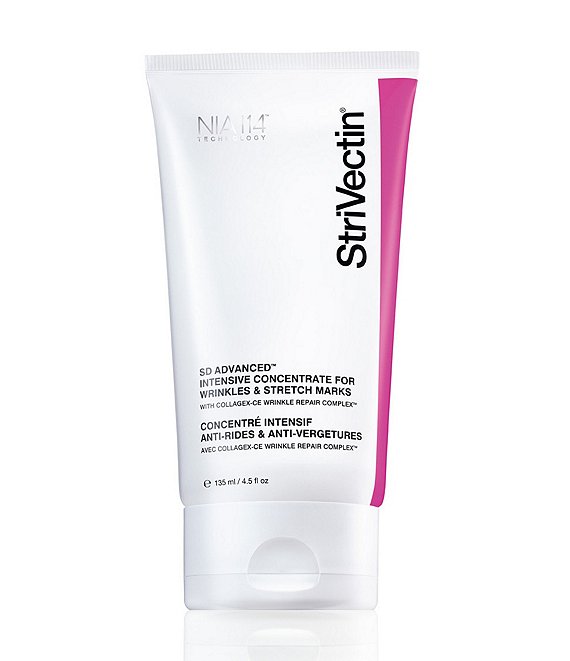STRIVECTIN

What is Strivectin?
Strivectin is a product line consisting of several topical creams that are used to reduce to appearance of wrinkles and stretch marks. The products contain skin-firming agents including hydration and elastin producing elements that help improve the appearance and overall firmness of the skin. It is recommended that the cream is used three times daily for stretch marks and twice daily to affected areas for wrinkles.
StriVectin is the main component in a skin repair cream for stretch marks, wrinkles and aging skin. This product is available without a prescription from the company Klein-Becker USA. StriVectin-SD® is the product that contains this compound, and is described as “a super-charged” with 8% of the patented molecule “NIA-114™” and additional Peptide Actives which are collagen producers. (1)
Strivectin Claims and Uses
According to the website strivectin.com, the product will “improve the appearance of wrinkles and stretchmarks in just 2-8 weeks. And even better, results keep improving over time, if you keep using our products twice a day.” (2) They report that in week 2 with using the product your skin begins the process of natural collagen resurging; texture and resilience improving. In week 4 there is increased cell turnover and fading discolorations. (2) At week 8, the skin has increased elasticity and wrinkles and stretch marks are visibly diminishing.
To use the cream, directions to reduce wrinkles and stretch marks include use twice a day both morning and night on cleansed skin, massaging into targeted areas. (2) The product also contains “Advanced Moisture Complex, ceramides and sodium hyaluronate to provide multi-level hydration”. (2)
Science Behind Srivectin
According to the website, the molecule NIA-114™ is a patented form of the nutrient niacin (nicotinic acid) which is found in skin. However, unlike other forms of Niacin, NIA-114™ is a very active form of the molecule with a lipophilic tail (tail of fatty acids). (1) This tail allows the molecule to penetrate the lipophilic (fat-loving) skin barrier called the stratum corneum (outermost layer of the skin) and diffuse down across the epidermis to deeper layers of the skin. As natural enzymes in the skin cleave the lipophilic tail, NIA-114™ converts back into nicotinic acid which is converted into NAD, which enters the skin’s cells and aids in various biochemical reactions including DNA repair, release of Leptin that promotes healing of the skin cells through wound repair and also reduces hyperpigmentation through melansome transfer inhibition. (3)
The molecule was discovered in skin cancer prevention research by Dr. Myron & Elaine Jacobson, and is reported to “repair skin damage and helps to rebuild skin layers.” (1) The peptides included in the product are protein fragments that penetrate skin and stimulate specialized cells called fibroblasts to synthesize collagen (specifically, type IV). (1) Collagen is located in the dermis and provides structure and support to the skin. With age collagen decreases, and it is crucial in preventing the appearance of wrinkles, stretch marks and lost elasticity. (1) The product also contains antioxidants to protect skin cells against damage caused by free radicals, moisturizers, and water-binders which hydrate skin to replace lost moisture. (1)
Studies
Due to the large market for wrinkle reduction products, a study undertook evaluation of several nonprescription products including StriVectin-SD® that report similar or better outcomes than botulinum toxin type A (Botox® Cosmetic) for treating wrinkles. (4) The study compared the efficacy and safety of botulinum toxin type A to placebo and three topical products (StriVectin-SD®, Wrinkle Relax™, and HydroDerm™) in treating moderate-to-severe glabellar lines. (4)
This was only a single-center randomized study with 77 female subjects, however botulinum toxin type A treatment consistently resulted in statistically significant reductions in wrinkle severity. However treatment with any of the three topical creams did not result in a significant difference from placebo. Additionally, three adverse events occurred in three subjects who received StriVectin-SD. (4) Although there is ample evidence to support the use of some topical preparations for the improvement in the appearance of fine lines, consumers may fail to distinguish between fine lines resulting from photoaging and the deeper lines resulting from hyperfunctional facial muscle activity which should, according to this study, be treated with botulinum toxin type A.
Additionally, in the article Kiss and Make-Up: A Need for Consolidation of FDA and Cosmetic Industry Regulation Programs, the author writes that in 2005 the FDA issued a warning to Basic Research of StriVectin-SD (6), questioning the claims made by the company and warning that the claims would classify the product as a drug. (5) However, by that time the earnings from the product were almost $100 million in 2005. (5)
Side Effects and Warnings
The molecule NIA-114™ helps to boost cell turnover, and the main side effect is warmth or blushing upon first application, which should typically last no more than 1-2 hours. This is because Niacin in the product causes small blood vessels in the skin to expand and increase blood flow, presenting as a warm, red, sometimes itchy feeling on the skin. (2) If this is uncomfortable a cold compress can be used on the area and lighter application of the product can be utilized. (2)
References:
- Beer, K. Comparative Evaluation of the Safety and Efficacy of Botulinum Toxin Type A and Topical Creams for Treating Moderate-to-Severe Glabellar Rhytids. Issue Volume 32, Issue 2, pages 184–192, February 2006
- Mason, Deborah E. Kiss and Make-Up: A Need for Consolidation of FDA and Cosmetic Industry Regulation Programs. Health Matrix: HeinOnline. 2008. Page 183.
- The Patients Guide to Stretch Marks. http://www.stretchmarks.org/creams.aspx#strivectin


